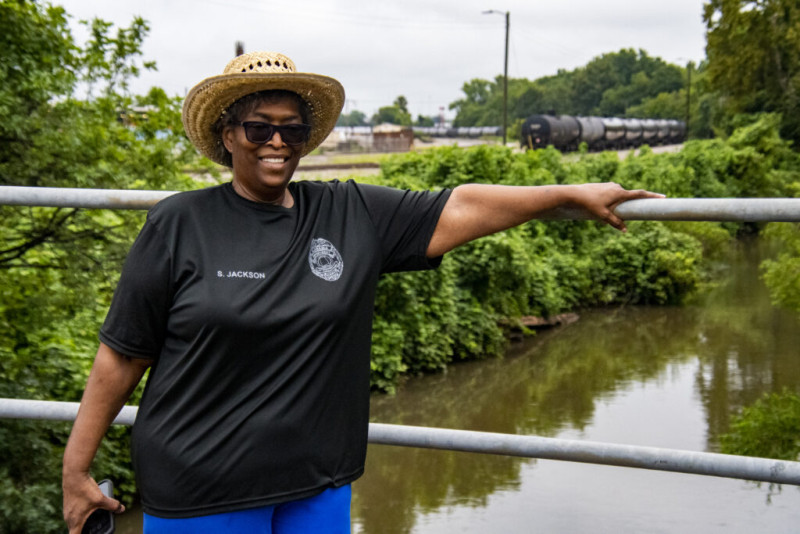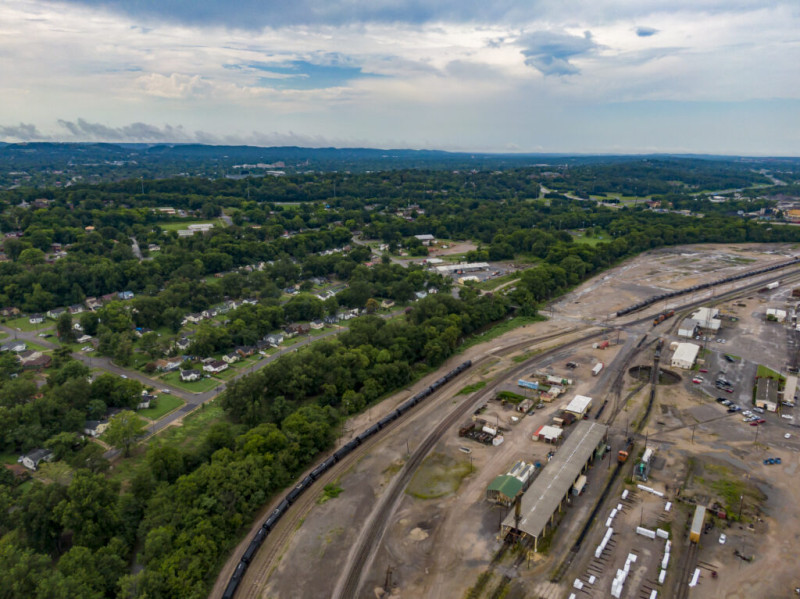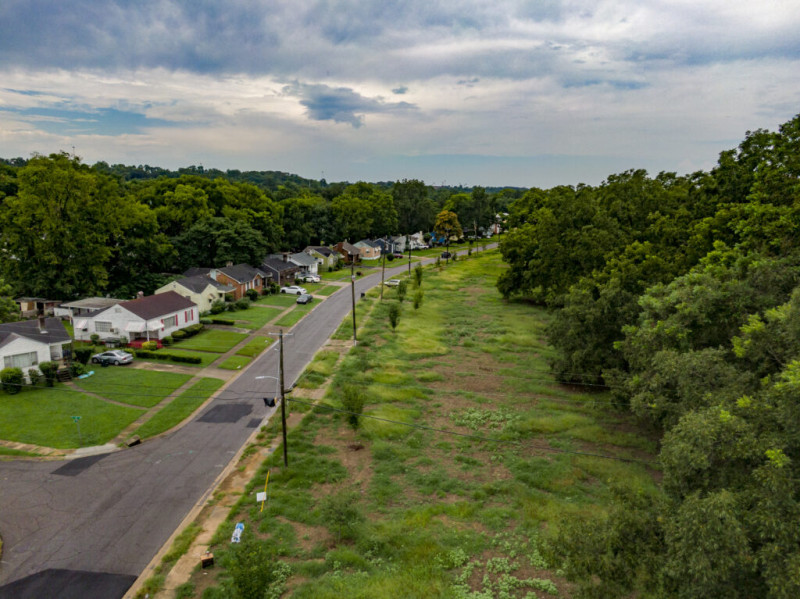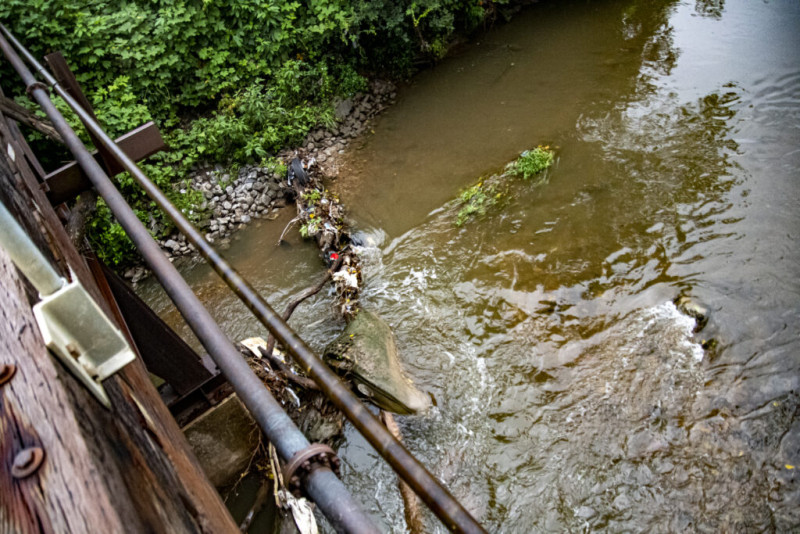A Tree Grows in Birmingham
BIRMINGHAM, Ala.—Sometimes Thomasine Jackson can’t get to work.
Jackson, 65, said if there’s been a hard rain, water covers her entire street, leaving her no choice but to call her supervisor at Drummond Coal and tell him she can’t make it in.
“It is what it is,” she said one humid August day, standing in the front yard of her modest brick home in Birmingham. Overhead, an Alabama thunderstorm was already brewing.
Jackson may work for a coal company, but she knows the science. Climate change, she understands, will only make conditions worse.

That reality is why Jackson has become known as the “tree lady” in the East Thomas community, where she serves as president of the neighborhood association. And it’s why those like Jackson—with the support of a local nonprofit and the county’s health department—aim to plant more trees in her neighborhood and beyond. Increasing the tree canopy in urban areas like Birmingham can help to mitigate the everyday impacts of climate change, experts and advocates have said, while also simply improving the lives of residents.
“Public Health Threat”
Dr. Mark Wilson knows the value of a good tree.
Wilson has served for more than a decade as Jefferson County, Alabama’s health officer.
He said that in recent years, he’s thought more intently about the Jefferson County Department of Health’s role in addressing the causes and impacts of climate change.
“You know, historically, I’ve been kind of warned that in Alabama, you might want to be careful about using that term, from a political standpoint,” Wilson explained in an interview. “But I just feel like it’s too important and that we needed to start addressing it as a health department and maybe lead by example a little bit.”
Earlier this year, the county’s health board took the step of declaring climate change a public health threat.
Wilson said that much shouldn’t be controversial.
“It’s obvious,” he said.
What’s also undeniable, Wilson said—particularly in the Alabama August—is the need for more shade in Birmingham and surrounding Jefferson County.

“Even around our own health department, if I walk two or three blocks from here, if you’re walking on a sidewalk with no trees, it’s almost unbearable,” he said.
Excessive heat can be especially dangerous for people outside for extended periods, like construction or postal workers, or for those who may not have adequate housing or air conditioning on hot days, Wilson explained.
“Some elderly people may not have air conditioning at all or may not be able to afford it so they might die of heat-related illness in their own home when it gets extreme,” Wilson said. “Having shade around the building you live in can reduce the baseline temperature and lower air conditioning costs.”
Trees provide other benefits, too.
“Trees improve air quality, and they take on stormwater that often floods out low-income communities,” said Francesca Gross. She’s the program manager at Cool Green Trees, a local nonprofit aimed at mitigating climate change by increasing planting “the right trees in the right place.”
Gross had been planting trees in low-income areas on a shoestring budget until earlier this year when she was approached by Wilson, who was looking for a partner who could be the “boots on the ground” for a tree-planting project.
“In the nonprofit world, it’s almost unprecedented to have someone to take something you’ve been working on and fund it in such an impactful way,” Gross said.
Under Wilson’s leadership, the Jefferson County Department of Health committed $400,000 to the project for the first year and $250,000 for an additional four years.
He said the move isn’t just beneficial for public health. It’s good for the department, too.
“We have a fleet of about 100 cars, for example,” Wilson said. “So we have a carbon footprint as a department … This is a sort of soft way of doing our part.”
The money will soon pay off. Cool Green Trees will begin its first planting season using health department funding this fall.
It’s something the nonprofit’s staff is excited to begin.
“It’s the smell of pine needles on the ground,” said Patrick McMahon, Cool Green Trees’ urban arborist. “And the leaves changing colors through the seasons. That’s what inspires me.”
Like Wilson, McMahon was a Boy Scout who had grown up more accustomed to being outside than in.
“My parents never let me inside,” he said, laughing.
Soon, McMahon will put his skills to work, helping residents like Jackson plant trees for their future.
Of Faith and Floods
Jackson can remember when there were houses across the street from hers, lined up side-by-side just like their neighbors.
But in the early 1990s, all the residents were forced out, she said—displaced by the threat of constant flooding from Village Creek, which snaked across their backyards, separating the mostly Black residents from an industrial railway. The homes were torn down, Jackson explained, and only green space remained.

Since then, Jackson said, she’s held onto faith—a firm, abiding belief that her home, unlike the ones across the street, won’t soon succumb to the creeping waters of Village Creek.
But it was the fear that first brought the idea to Jackson’s mind, she said.
The last time her street flooded, leaving her stuck at home from work, Jackson began to consider ways the neighborhood could help to mitigate the flooding.
“I thought there had to be a way to plant trees that would suck up the water,” she said. “We just have to know what kind of trees to put there.”
Jackson began doing research about the best ways to mitigate flooding through landscaping. That’s how she connected with Francesca Gross of Cool Green Trees.
The pair had already begun looking into solutions when the World Games, an international sporting event, came to the Magic City.
Jackson said they saw the event as an opportunity.
“You know when these big events come, they have to do a sustainability project,” Jackson said.
Soon, the World Games and Vulcan Material Company, one of the nation’s largest producers of construction materials, were working with Jackson and Gross to place 35 trees in 35 vacant lots along the flood zone. The trees were planted in November 2021, less than a year before the start of the games in Birmingham.
Jackson knows her neighborhood won’t see the full benefit of the new trees for years, but she feels like it’s a step in the right direction, no matter how small.
Urban Heat Islands
Dr. Wilson wasn’t exaggerating. The Jefferson County Department of Health’s office, located in downtown Birmingham, Alabama, is in the middle of what scientists call an “urban heat island,” an area of dense infrastructure that lacks tree cover and is often several degrees hotter than the surrounding suburban and rural areas.
A review of studies cited by the Environmental Protection Agency shows that daytime temperatures in urban areas like Birmingham can be up to seven degrees warmer than outlying areas during the day.
“Research predicts that the heat island effect will strengthen in the future as the structure, spatial extent, and population density of urban areas change and grow,” the agency has said.
Gross hopes projects like Cool Green Trees can help mitigate the impact of urban heat islands, which often disproportionately impact minority communities.
To aid in their work, the organization collaborated with a mapping expert at the University of Alabama at Birmingham to visualize factors that would help their team identify both the scope of the problem and the best opportunities for change.
She said the resulting story map can help community members see the impact of climate change on their own neighborhoods and those around them.
“And when you look, you can also see the results of being in a low income area and the long-term health results of that,” Gross said.
A report published in July in Science Advances which included subjects from the Birmingham area showed that individuals who lived near green spaces “were biologically 2.5 years younger, on average, than those who live near less greenness.”
“When we think about staying healthy as we get older, we usually focus on things like eating well, exercising and getting enough sleep,” the study’s first author, Dr. Kyeezu Kim, a postdoctoral scholar in Preventive Medicine at Northwestern University’s Feinberg School of Medicine, said. “However, our research shows that the environment we live in, specifically our community and access to green spaces, is also important for staying healthy as we age.”
In cities across the country, including in the South, those impacts also have a racial disparity—a result of systemically racist systems built over decades.
“If you put a map of the redlining in Birmingham with a map of the tree canopy, … it matches up almost exactly,” Gross has said.
It’s something Wilson said the health department is committed to addressing.
“Our health department has embraced health equity, and promoting health equity, and putting extra resources into those communities that are underserved, or may have health disparities based on our history of racism and other issues of poverty and such,” he said.
Addressing urban heat islands, then, is a way to move towards that goal of not allowing race or place to determine health outcomes.
“Most of these urban heat islands in our area are in low-income neighborhoods that have historically been deprived of resources,” Wilson said. “This is promoting health equity.”
A Daughter of Dynamite Hill
That history—of redlines and green spaces—is part of the soul of East Thomas, the neighborhood where Jackson has spent her life.
In the first years of her life, the community had a more infamous name: Dynamite Hill.
But it’s the solutions, not the problems, that keep Jackson moving forward, one step at a time.
On an August morning, she walked along a bridge over Village Creek, pointing to debris preventing the water below from flowing freely.
It’s trying to fix things like this—tangible issues like this Beautyrest mattress blocking the waterway—that make her feel she’s making a difference when it comes to an issue that feels almost insurmountable.

And, Jackson said, those small changes may just help keep Village Creek from creeping up to her and her neighbors’ doors too. She’s recently renovated her home, she said, and she doesn’t plan to leave.
She has no choice but to keep the water at bay.
“But I’ve got faith,” she said, smiling. “I’ve got complete faith.”
Disclaimer: The copyright of this article belongs to the original author. Reposting this article is solely for the purpose of information dissemination and does not constitute any investment advice. If there is any infringement, please contact us immediately. We will make corrections or deletions as necessary. Thank you.







